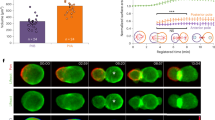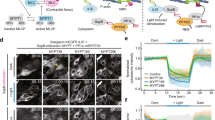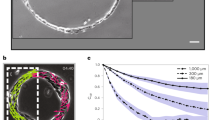Abstract
Asymmetric cell divisions are essential for the development of multicellular organisms. To proceed, they require an initially symmetric cell to polarize1. In Caenorhabditis elegans zygotes, anteroposterior polarization is facilitated by a large-scale flow of the actomyosin cortex2,3,4, which directs the asymmetry of the first mitotic division. Cortical flows appear in many contexts of development5, but their underlying forces and physical principles remain poorly understood. How actomyosin contractility and cortical tension interact to generate large-scale flow is unclear. Here we report on the subcellular distribution of cortical tension in the polarizing C. elegans zygote, which we determined using position- and direction-sensitive laser ablation. We demonstrate that cortical flow is associated with anisotropies in cortical tension and is not driven by gradients in cortical tension, which contradicts previous proposals5. These experiments, in conjunction with a theoretical description of active cortical mechanics, identify two prerequisites for large-scale cortical flow: a gradient in actomyosin contractility to drive flow and a sufficiently large viscosity of the cortex to allow flow to be long-ranged. We thus reveal the physical requirements of large-scale intracellular cortical flow that ensure the efficient polarization of the C. elegans zygote.
This is a preview of subscription content, access via your institution
Access options
Subscribe to this journal
Receive 51 print issues and online access
$199.00 per year
only $3.90 per issue
Buy this article
- Purchase on Springer Link
- Instant access to full article PDF
Prices may be subject to local taxes which are calculated during checkout




Similar content being viewed by others
References
Horvitz, H. R. & Herskowitz, I. Mechanisms of asymmetric cell division: two Bs or not two Bs, that is the question. Cell 68, 237–255 (1992)
Hird, S. N. & White, J. G. Cortical and cytoplasmic flow polarity in early embryonic cells of Caenorhabditis elegans . J. Cell Biol. 121, 1343–1355 (1993)
Goldstein, B. & Hird, S. N. Specification of the anteroposterior axis in Caenorhabditis elegans . Development 122, 1467–1474 (1996)
Munro, E., Nance, J. & Priess, J. R. Cortical flows powered by asymmetrical contraction transport PAR proteins to establish and maintain anterior-posterior polarity in the early C. elegans embryo. Dev. Cell 7, 413–424 (2004)
Bray, D. & White, J. G. Cortical flow in animal cells. Science 239, 883–888 (1988)
Cowan, C. R. & Hyman, A. A. Centrosomes direct cell polarity independently of microtubule assembly in C. elegans embryos. Nature 431, 92–96 (2004)
Cheeks, R. J. et al. elegans PAR proteins function by mobilizing and stabilizing asymmetrically localized protein complexes. Curr. Biol. 14, 851–862 (2004)
Motegi, F. & Sugimoto, A. Sequential functioning of the ECT-2 RhoGEF, RHO-1 and CDC-42 establishes cell polarity in Caenorhabditis elegans embryos. Nature Cell Biol. 8, 978–985 (2006)
Zonies, S., Motegi, F., Hao, Y. & Seydoux, G. Symmetry breaking and polarization of the C. elegans zygote by the polarity protein PAR-2. Development 137, 1669–1677 (2010)
Kruse, K., Joanny, J.-F., Jülicher, F., Prost, J. & Sekimoto, K. Generic theory of active polar gels: a paradigm for cytoskeletal dynamics. Eur. Phys. J. E 16, 5–16 (2005)
Munro, E. M. & Bowerman, B. Cellular symmetry breaking during Caenorhabditis elegans development. Cold Spring Harb. Perspect. Biol. 1, a003400 (2009)
Wozniak, M. A. & Chen, C. S. Mechanotransduction in development: a growing role for contractility. Nature Rev. Mol. Cell Biol. 10, 34–43 (2009)
Lecuit, T. & Lenne, P.-F. Cell surface mechanics and the control of cell shape, tissue patterns and morphogenesis. Nature Rev. Mol. Cell Biol. 8, 633–644 (2007)
Grill, S. W., Gönczy, P., Stelzer, E. & Hyman, A. A. Polarity controls forces governing asymmetric spindle positioning in the Caenorhabditis elegans embryo. Nature 409, 630–633 (2001)
Mandato, C. A. & Bement, W. M. Contraction and polymerization cooperate to assemble and close actomyosin rings around Xenopus oocyte wounds. J. Cell Biol. 154, 785–797 (2001)
Wottawah, F. et al. Optical rheology of biological cells. Phys. Rev. Lett. 94, 098103 (2005)
Dai, J., Ting-Beall, H. P., Hochmuth, R. M., Sheetz, M. & Titus, M. A. Myosin I contributes to the generation of resting cortical tension. Biophys. J. 77, 1168–1176 (1999)
Pasternak, C., Spudich, J. A. & Elson, E. L. Capping of surface receptors and concomitant cortical tension are generated by conventional myosin. Nature 341, 549–551 (1989)
Strome, S. Fluorescence visualization of the distribution of microfilaments in gonads and early embryos of the nematode Caenorhabditis elegans . J. Cell Biol. 103, 2241–2252 (1986)
Hamill, D. R., Severson, A. F., Carter, J. C. & Bowerman, B. Centrosome maturation and mitotic spindle assembly in C. elegans require SPD-5, a protein with multiple coiled-coil domains. Dev. Cell 3, 673–684 (2002)
Schonegg, S., Constantinescu, A. T., Hoege, C. & Hyman, A. A. The Rho GTPase-activating proteins RGA-3 and RGA-4 are required to set the initial size of PAR domains in Caenorhabditis elegans one-cell embryos. Proc. Natl Acad. Sci. USA 104, 14976–14981 (2007)
Schmutz, C., Stevens, J. & Spang, A. Functions of the novel RhoGAP proteins RGA-3 and RGA-4 in the germ line and in the early embryo of C. elegans . Development 134, 3495–3505 (2007)
Glotzer, M. The molecular requirements for cytokinesis. Science 307, 1735–1739 (2005)
Humphrey, D., Duggan, C., Saha, D., Smith, D. & Käs, J. Active fluidization of polymer networks through molecular motors. Nature 416, 413–416 (2002)
Lieleg, O., Claessens, M. M. A. E., Luan, Y. & Bausch, A. R. Transient binding and dissipation in cross-linked actin networks. Phys. Rev. Lett. 101, 108101 (2008)
Aditi Simha, R. & Ramaswamy, S. Hydrodynamic fluctuations and instabilities in ordered suspensions of self-propelled particles. Phys. Rev. Lett. 89, 058101 (2002)
Salbreux, G., Prost, J. & Joanny, J.-F. Hydrodynamics of cellular cortical flows and the formation of contractile rings. Phys. Rev. Lett. 103, 058102 (2009)
Strome, S. & Wood, W. B. Generation of asymmetry and segregation of germ-line granules in early C. elegans embryos. Cell 35, 15–25 (1983)
Zhang, W. & Robinson, D. N. Balance of actively generated contractile and resistive forces controls cytokinesis dynamics. Proc. Natl Acad. Sci. USA 102, 7186–7191 (2005)
Rauzi, M., Verant, P., Lecuit, T. & Lenne, P.-F. Nature and anisotropy of cortical forces orienting Drosophila tissue morphogenesis. Nature Cell Biol. 10, 1401–1410 (2008)
Brenner, S. The genetics of Caenorhabditis elegans . Genetics 77, 71–94 (1974)
Nance, J., Munro, E. M. & Priess, J. R. C. elegans PAR-3 and PAR-6 are required for apicobasal asymmetries associated with cell adhesion and gastrulation. Development 130, 5339–5350 (2003)
Motegi, F., Velarde, N. V., Piano, F. & Sugimoto, A. Two phases of astral microtubule activity during cytokinesis in C. elegans embryos. Dev. Cell 10, 509–520 (2006)
Timmons, L. & Fire, A. Specific interference by ingested dsRNA. Nature 395, 854 (1998)
Timmons, L., Court, D. L. & Fire, A. Ingestion of bacterially expressed dsRNAs can produce specific and potent genetic interference in Caenorhabditis elegans . Gene 263, 103–112 (2001)
Raffel, M., Willert, C. E., Wereley, S. T. & Kompenhans, J. Particle Image Velocimetry: A Practical Guide. (Springer, 2007)
Sveen, J. & Cowen, E. in PIV and Water Waves: Advances in Coastal and Ocean Engineering Vol. 9 (eds Grue, J., Liu, P. L. F. & Pedersen, G. K.) Ch 1 (World Scientific, 2004)
Hiramoto, Y. Rheological properties of sea urchin eggs. Biorheology. 6, 201–234 (1970)
Grill, S. W., Howard, J., Schäffer, E., Stelzer, E. H. K. & Hyman, A. A. The distribution of active force generators controls mitotic spindle position. Science 301, 518–521 (2003)
Daniels, B. R., Masi, B. C. & Wirtz, D. Probing single-cell micromechanics in vivo: the microrheology of C. elegans developing embryos. Biophys. J. 90, 4712–4719 (2006)
Strome, S. & Hill, D. P. Early embryogenesis in Caenorhabditis elegans: the cytoskeleton and spatial organization of the zygote. Bioessays 8, 145–149 (1988)
Velarde, N., Gunsalus, K. C. & Piano, F. Diverse roles of actin in C. elegans early embryogenesis. BMC Dev. Biol. 7, 142 (2007)
Gardel, M. L. et al. Elastic behavior of cross-linked and bundled actin networks. Science 304, 1301–1305 (2004)
Gardel, M. L. et al. Stress-dependent elasticity of composite actin networks as a model for cell behavior. Phys. Rev. Lett. 96, 088102 (2006)
Hill, D. P. & Strome, S. An analysis of the role of microfilaments in the establishment and maintenance of asymmetry in Caenorhabditis elegans zygotes. Dev. Biol. 125, 75–84 (1988)
Hyman, A. A. & White, J. G. Determination of cell division axes in the early embryogenesis of Caenorhabditis elegans . J. Cell Biol. 105, 2123–2135 (1987)
Shelton, C. A. & Bowerman, B. Time-dependent responses to glp-1-mediated inductions in early C. elegans embryos. Development 122, 2043–2050 (1996)
Acknowledgements
We thank C. Cowan, N. Goehring, P. Gönczy, J. Howard, T. Hyman, M. Loose, F. Nédélec and K. Oegema for advice and suggestions on the manuscript. We are grateful to E. Munro for scientific advice, worm strains and discussions. M.M. is supported by a predoctoral fellowship from the Boehringer Ingelheim Fonds, and J.S.B. by a postdoctoral fellowship from the Human Frontier Science Program.
Author information
Authors and Affiliations
Contributions
M.M. performed the experiments; the presented ideas and the theory were developed together by all authors.
Corresponding author
Ethics declarations
Competing interests
The authors declare no competing financial interests.
Supplementary information
Supplementary Information
This file contains Supplementary Figures 1-14 with legends, Supplementary Materials and Methods, Supplementary Tables 1-2, Supplementary Notes, Text and Equations, legends for Supplementary Movies 1-14 and additional references. (PDF 11089 kb)
Supplementary Movie 1
This movie shows anterior COLA along the AP-axis in a polarising NMY-2::GFP Zygote - see Supplementary Information file for full legend. (MOV 4503 kb)
Supplementary Movie 2
This movie shows posterior COLA along the AP-axis in a polarising NMY 2::GFPZygote - see Supplementary Information file for full legend. (MOV 2165 kb)
Supplementary Movie 3
This movie shows anterior COLA along the AP-axis in a polarising GFP::MOE zygote - see Supplementary Information file for full legend. (MOV 4653 kb)
Supplementary Movie 4
This movie shows anterior COLA along the AP-axis in an NMY-2::GFP, spd 5(RNAi) zygote - see Supplementary Information file for full legend. (MOV 4007 kb)
Supplementary Movie 5
This movie shows posterior COLA along the AP-axis in a NMY-2::GFP, spd 5(RNAi) zygot - see Supplementary Information file for full legend e. (MOV 2791 kb)
Supplementary Movie 6
This movie shows anterior COLA along the AP-axis in a polarising NMY-2::GFP, ect-2(RNAi) zygote - see Supplementary Information file for full legend. (MOV 6554 kb)
Supplementary Movie 7
This movie shows anterior COLA along the AP-axis in a polarising NMY-2::GFP, rga 3(RNAi) zygote - see Supplementary Information file for full legend. (MOV 4448 kb)
Supplementary Movie 8
This movie shows anterior COLA orthogonal to the AP-axis in a polarizing NMY- 2::GFP zygote - see Supplementary Information file for full legend. (MOV 3547 kb)
Supplementary Movie 9
This movie shows anterior COLA orthogonal to the AP-axis in a NMY-2::GFP, spd-5(RNAi) zygote - see Supplementary Information file for full legend. (MOV 2833 kb)
Supplementary Movie 10
This movie shows posterior COLA orthogonal to the AP-axis in a NMY-2::GFP, spd- 5(RNAi) zygote - see Supplementary Information file for full legend. (MOV 1970 kb)
Supplementary Movie 11
This movie shows PIV of NMY-2::GFP during polarity establishment – see Supplementary Information file for full legend. (MOV 6355 kb)
Supplementary Movie 12
This movie shows posterior COLA orthogonal to the AP-axis in a polarising NMY-2::GFP zygote - see Supplementary Information file for full legend. (MOV 2660 kb)
Supplementary Movie 13
This movie shows external friction, internal viscosity and the hydrodynamic length scale - see Supplementary Information file for full legend. (MOV 566 kb)
Supplementary Movie 14
This movie shows the period of cortical flow in a GFP::MOE zygote treated with Cytochalasin D - see Supplementary Information file for full legend. (MOV 2226 kb)
Rights and permissions
About this article
Cite this article
Mayer, M., Depken, M., Bois, J. et al. Anisotropies in cortical tension reveal the physical basis of polarizing cortical flows. Nature 467, 617–621 (2010). https://doi.org/10.1038/nature09376
Received:
Accepted:
Published:
Issue Date:
DOI: https://doi.org/10.1038/nature09376
This article is cited by
-
Friction forces determine cytoplasmic reorganization and shape changes of ascidian oocytes upon fertilization
Nature Physics (2024)
-
Friction pulls cells into shape
Nature Physics (2024)
-
Spontaneous rotations in epithelia as an interplay between cell polarity and boundaries
Nature Physics (2024)
-
Intracellular tension sensor reveals mechanical anisotropy of the actin cytoskeleton
Nature Communications (2023)
-
A gelation transition enables the self-organization of bipolar metaphase spindles
Nature Physics (2022)
Comments
By submitting a comment you agree to abide by our Terms and Community Guidelines. If you find something abusive or that does not comply with our terms or guidelines please flag it as inappropriate.



